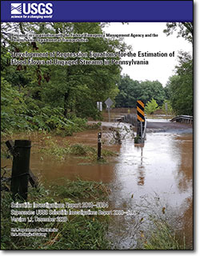Development of Regression Equations for the Estimation of Flood Flows at Ungaged Streams in Pennsylvania
Links
- Document: Report (15.8 MB pdf)
- Appendixes:
- Appendix 1 (81.4 KB xlsx) - Unregulated streamgages considered for the development of updated flood-flow regression equations for Pennsylvania streams
- Appendix 2 (389 KB xlsx) - Magnitude, variance, and confidence intervals of annual exceedance probability floods for select unregulated streamgages in Pennsylvania and surrounding states
- Appendix 3 (40.1 KB xlsx) - Magnitude, variance, and confidence intervals of annual exceedance probability floods for select streamgages in Pennsylvania substantially affected by upstream regulation
- Data Releases:
- USGS data release - Data in support of development of regression equations for the estimation of flood flows at ungaged streams in Pennsylvania
- USGS data release - Data in support of Development of Regression Equations for the Estimation of Flood Flows at Ungaged Streams in Pennsylvania
- Version History: Version History (1.09 KB txt)
- Superseded Publications:
- Download citation as: RIS | Dublin Core
Abstract
Regression equations, which may be used to estimate flood flows at select annual exceedance probabilities, were developed for ungaged streams in Pennsylvania. The equations were developed using annual peak flow data through water year 2015 and basin characteristics for 285 streamflow gaging stations across Pennsylvania and surrounding states. The streamgages included active and discontinued continuous-record stations, as well as crest-stage partial-record stations, and required a minimum of 10 years of annual peak streamflow data for inclusion in the study. Explanatory variables significant at the 95-percent confidence level for one or more regression equations included the following basin characteristics: drainage area, maximum basin elevation, mean basin slope, percent storage, and the percentage of carbonate bedrock within a basin. The State was divided into five regions, and regional regression equations were developed to estimate flood flows associated with the 50-, 20-, 10-, 4-, 2-, 1-, 0.5-, and 0.2-percent annual exceedance probabilities (which correspond to the 2-, 5-, 10-, 25-, 50-, 100-, 200-, and 500-year recurrence intervals, respectively). Although the regression equations can be used to estimate the magnitude of flood flows for most streams in the State, they are not valid for streams with drainage areas generally greater than 1,500 square miles or with substantial regulation, diversion, or mining activity within the basin. The regional regression equations will be incorporated into the U.S. Geological Survey StreamStats application (https://water.usgs.gov/osw/streamstats/).
Additionally, annual peak flow data for 356 streamgages initially considered for inclusion in the analysis for development of updated flood-flow regression equations were analyzed for the existence of trends; estimates of flood-flow magnitude and frequency were also computed for these streamgages. Estimates of flood-flow magnitude and frequency for streamgages substantially affected by upstream regulation are also presented.
Suggested Citation
Roland, M.A., and Stuckey, M.H., 2020, Development of regression equations for the estimation of flood flows at ungaged streams in Pennsylvania (ver. 1.1, December 2020): U.S. Geological Survey Scientific Investigations Report 2019–5094, 36 p., https://doi.org/10.3133/sir20195094. [Supersedes USGS Scientific Investigations Report 2008–5102]
ISSN: 2328-0328 (online)
Study Area
Table of Contents
- Abstract
- Introduction
- Streamgage Selection and Data Analysis
- Basin and Climate Characteristics
- Development of Regression Equations
- Estimating Flood Flows at Ungaged Sites Near a Streamgage
- General Guidelines for the Estimation of Magnitude and Frequency of Flood Flows
- Summary
- Acknowledgments
- References Cited
- Appendixes 1, 2, and 3
| Publication type | Report |
|---|---|
| Publication Subtype | USGS Numbered Series |
| Title | Development of regression equations for the estimation of flood flows at ungaged streams in Pennsylvania |
| Series title | Scientific Investigations Report |
| Series number | 2019-5094 |
| DOI | 10.3133/sir20195094 |
| Edition | Version 1.0: October 2019; Version 1.1: December 2020 |
| Publication Date | October 28, 2019 |
| Year Published | 2019 |
| Language | English |
| Publisher | U.S. Geological Survey |
| Publisher location | Reston, VA |
| Contributing office(s) | Pennsylvania Water Science Center |
| Description | Report: vi, 36 p.; Appendices 1-3; Data Release |
| Public Comments | Scientific Investigations Report 2019-5094 supersedes Scientific Investigations Report 2008–5102. |
| Country | United States |
| State | Pennsylvania |
| Online Only (Y/N) | Y |
| Additional Online Files (Y/N) | Y |


